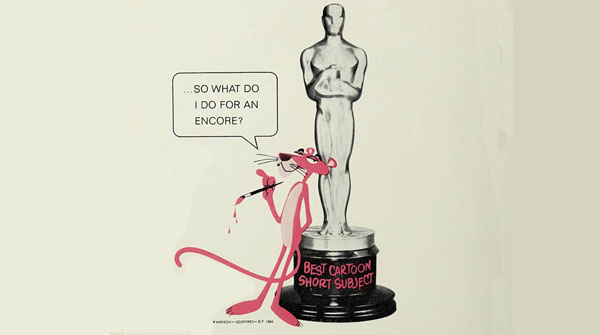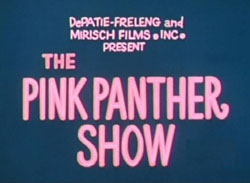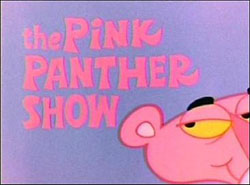
Animated opening credits were a popular trend in live-action films, acting almost like a cartoon short within the movie itself and as an entertaining way to draw audiences into the film that was to follow.
One of the most famous of these was part of director Blake Edwards classic 1963 comedy heist film, The Pink Panther. The film centered on the theft of a diamond, which looked as if a pink panther was leaping within it when held up to the light.
 This unique name inspired animated opening credits featuring the titular panther, mischievously interacting with the titles and staying one step ahead of an animated version of Inspector Clouseau (made famous in the films by the brilliant Peter Sellers) all set to one of the most famous music scores in movie history by Henry Mancini.
This unique name inspired animated opening credits featuring the titular panther, mischievously interacting with the titles and staying one step ahead of an animated version of Inspector Clouseau (made famous in the films by the brilliant Peter Sellers) all set to one of the most famous music scores in movie history by Henry Mancini.
The titles were directed by the legendary Friz Freleng, who spent a large part of his career at Warner Bros., where he created many of that Studio’s most famous animated stars. The titles had been produced by DePatie-Freleng Enterprises, which had been formed by Freleng and executive David H. DePatie.
The opening credits were such a hit with audiences that United Artists signed the Studio to begin producing short subjects featuring the Pink Panther. The first of these, The Pink Phink, won the 1964 Oscar.
 The character’s popularity eventually led him to Saturday morning television fifty-five years ago this month, when The Pink Panther Show debuted on September 6th, 1969, on NBC. The series would feature two Pink Panther shorts, and sandwiched in the middle would be a short subject starring an animated version of the Inspector. Actor Marvin Miller also narrated Pink Panther’s short “bumper” segments.
The character’s popularity eventually led him to Saturday morning television fifty-five years ago this month, when The Pink Panther Show debuted on September 6th, 1969, on NBC. The series would feature two Pink Panther shorts, and sandwiched in the middle would be a short subject starring an animated version of the Inspector. Actor Marvin Miller also narrated Pink Panther’s short “bumper” segments.
The Pink Panther shorts worked so well and connected with audiences because the character, who didn’t speak and expressed himself through comedic pantomime personality, was in the tradition of silent films and other cartoon stars like Felix the Cat and Tom and Jerry.
The conceits of the shorts were fairly simple but resulted in creative humor – in “Slink Pink,” the Pink Panther attempts to escape the cold by sneaking into a nice, warm house, only to find that it’s the home of a big game hunter and he must pose as one of his stuffed taxidermy conquests. The Panther continually outsmarts the hunter’s suspicious dog and stays in the house. “Pink Suds” finds the Pink Panther at the laundromat, tangling with the washers, dryers, and other patrons.
 In these and other shorts, the put-upon target of the Pink Panther’s mischief was a short man with a cartoonishly large nose and bristle mustache, known as “The Little Man.”
In these and other shorts, the put-upon target of the Pink Panther’s mischief was a short man with a cartoonishly large nose and bristle mustache, known as “The Little Man.”
Several talented animation veterans brought the Pink Panther to the screen, including writer John Dunn and directors Hawley Pratt, Gerry Chiniquy, and Sid Marcus.
Other animated segments would eventually join The Pink Panther Show as it evolved through its lengthy run on Saturday morning. These included The Aardvark and the Ant (both voiced by comedian John Byner, where the former talked like Jackie Mason and the latter, like Dean Martin), the self-explanatory Tijuana Toads (voiced by Larry D. Mann and Don Diamond) and Misterjaw (Arte Johnson) about a top-hat sporting great white shark, which sprang from the popularity of Jaws.
 From his debut series, the Pink Panther remained a fixture on Saturday mornings for many years, changing titles, such as The Think Pink Panther Show and The Pink Panther Laugh and a Half, Hour and a Half Show, and eventually shifting networks to ABC.
From his debut series, the Pink Panther remained a fixture on Saturday mornings for many years, changing titles, such as The Think Pink Panther Show and The Pink Panther Laugh and a Half, Hour and a Half Show, and eventually shifting networks to ABC.
The character would gain a family in the 1980s with Pink Panther and Sons and was given a voice provided by actor Matt Frewer in a 1990s incarnation.
But, throughout the series and character changes since his TV debut fifty-five years ago, The Pink Panther has remained the animated gem that audiences first fell in love with during those opening titles in 1963.


 Michael Lyons is a freelance writer, specializing in film, television, and pop culture. He is the author of the book, Drawn to Greatness: Disney’s Animation Renaissance, which chronicles the amazing growth at the Disney animation studio in the 1990s. In addition to Animation Scoop and Cartoon Research, he has contributed to Remind Magazine, Cinefantastique, Animation World Network and Disney Magazine. He also writes a blog, Screen Saver: A Retro Review of TV Shows and Movies of Yesteryear and his interviews with a number of animation legends have been featured in several volumes of the books, Walt’s People. You can visit Michael’s web site Words From Lyons at:
Michael Lyons is a freelance writer, specializing in film, television, and pop culture. He is the author of the book, Drawn to Greatness: Disney’s Animation Renaissance, which chronicles the amazing growth at the Disney animation studio in the 1990s. In addition to Animation Scoop and Cartoon Research, he has contributed to Remind Magazine, Cinefantastique, Animation World Network and Disney Magazine. He also writes a blog, Screen Saver: A Retro Review of TV Shows and Movies of Yesteryear and his interviews with a number of animation legends have been featured in several volumes of the books, Walt’s People. You can visit Michael’s web site Words From Lyons at: 






















I have many fond memories of the Pink Panther. Henry Mancini’s theme was one of the first pieces I learned to play on the piano, and I played it incessantly. One of my favourite Pink Panther cartoons is “Pink, Plunk, Plink”, in which our hero continually interrupts an orchestra concert by playing his own theme music, and in the end is applauded by the sole member of the audience — Henry Mancini himself. Later I had the pleasure of seeing Mancini in concert, which was a highlight of my teen years. The guy was an outstanding flutist.
Post put out a Pink Panther Flakes cereal during the TV show’s heyday. The pink sugar frosting dissolved quickly in milk, so that after about a minute it looked like a bowl of cornflakes swimming in Pepto-Bismol. I remember that the animated commercials for it (which, under FCC regulations, would not have been allowed to air during the Pink Panther Show itself) had original lyrics set not only to Mancini’s movie theme, but also to Doug Goodwin’s up-tempo theme to the TV show.
Our local NBC affiliate could be picked up on AM radio, and I remember Boy Scout campouts where a bunch of us would gather around a little transistor radio and listen to cartoon soundtracks on Saturday morning. Everyone liked the Pink Panther cartoons best. Because they lacked dialogue, it was fun to try and figure out what was happening based on the music and sound effects alone.
Of the show’s other segments, my favourite by far was the Ant and the Aardvark. (Yes, I know “aardvark” comes first in the dictionary, but not in the title of the series.) One year I made an Aardvark costume for Halloween. The papier-mâché mask took some doing, but I was proud of the result; the rest was just a blue shirt and pants. (I didn’t bother with the tail.) When I went trick-or-treating, I told the people at each house, in John Byner’s Jackie Mason voice, that I was an anteater but would settle for candy if they didn’t have any ants handy. “But one of these days I’ll catch that ant, and when I do, he’ll be a dead ant!” Then I’d walk away, vocalising the Pink Panther theme: “Dead ant, dead ant, dead ant dead ant dead ant dead ant dead aaaaaaaaant….” Come to think of it, why didn’t the Aardvark ever do that in the cartoons? It would have made a great crossover.
The Pink Panthermobile was a real-life custom car, seen in the show’s opening and closing titles. My brother had a model of it. It looked really cool, but, lacking a windshield, it probably wouldn’t have been safe to drive in traffic.
That’s got to be Don Messick narrating that promo. Did he do any other work for DePatie-Freleng?
There was a fourth director of Pink Panther cartoons whom you failed to mention: Robert McKimson, who sadly gets overlooked all too often. But thanks for not overlooking the Pink Panther Show on its 55th anniversary!
Don Messick was in DFE’s “Dr. Dolittle” series and voiced a younger version of Sgt. Deux Deux in The Inspector short, “La Feet’s Defeat.”
Messick was also a regular in 1973’s BAILEY’S COMETS, and did incidentals in selected episodes of THE BARKLEYS, THE HOUNDCATS and THE ODDBALL COUPLE.
Wow, cartoons of even greater obscurity!
As I recall, the Pink Panther Show was a welcome addition to Saturday mornings. From its opening theme song with clever lyrics, the show seemed to catch everybody’s attention. Even our parents, who rarely watched with us on Saturday mornings, were somewhat captivated by the Pink Panther.
One Friday evening in mid-October, our church held a special showing of Chaplin’s classic film “The Gold Rush” accompanied by our choir director/organist on the church organ. Silent movies were, by that time, a relic of the past–though not as completely culturally foreign as they are to this generation. I believe the audience, consisting primarily of families, was spellbound and somewhat enchanted by this medium. Our choir director provided not only accompaniment during the movie, but commentary before and after that added to one’s appreciation of these films from a bygone era. It was like a new discovery.
The following morning was Saturday, of course, and we were all of us still under the enchantment of the previous evening’s entertainment. My brother and I were avidly watching the Pink Panther, and my mother came into the living room and observed, “The Pink Panther is kind of like silent movies.”
And we all agreed.
Yes, that is definitely Don Messick’s voice in the promo. Clearly the show was in development at the time. A fascinating look at how it was originally pitched. Thanks for sharing. Brings back some great memories.
No mention of the laugh tracks that were added for the Saturday AM broadcasts? I was so used to those that when I saw the DFE shorts in syndication later, their absence seemed off-putting. Now, after all these years without the canned guffaws, when I occasionally see an old NBC edit of the cartoons, its weird again.
The Tijuana Toads were rechristened The Texas Toads for network airings, and they also had their voices redubbed. Never saw the originals until decades later.
While Larry D, Mann was in those shorts (as Crazy Legs Crane) the writer didn’t mention Tom Holland, who was Pancho/Banjo to Don Diamond’s El Toro/Fatso.
I guess I got lucky when BBC showed them because almost none of those had laugh tracks, especially not the Panther/Inspector/Panther version. I don’t mind them so much in Ant & Aardvark or CL Crane, just because of the way the characters speak like stand-up comics, but I can’t stand them in the Panthers and Inspectors.
Speaking of that, I’d guess that the blu-ray collection of all the theatrical shorts does not have the laugh track on top, correct? It’s out of print so I doubt it’s a purchase for myself anytime soon, but I’d certainly want to know that detail before paying too much to get it.
Happy 55th.anniversary,Pink!
Just how long was the Pink Panther Show in development? The demo reel mentions the Matzoriley Brothers, who were given their own segment on The Super 6 in 1966. Also, all the PP clips are from some of the earliest shorts.
What ever happened with Mr. Hornsby -if that was the name-, the W.C. Fields alter ego?
How early was this promo made? It seems to only feature clips from the very earliest Pink Panther shorts and it doesn’t show anything from The Inspector shorts at all. I seem to recall hearing somewhere that there was a push to get PP on the TV ASAP, but DFE (sorry for all the initials) wanted to hold off on that as long as possible and stay in theatricals. So it makes sense that this promo was done not long after the titles and the initial shorts were made. Don Messick also mentions 26 Inspector shorts, when 34 ended up getting made.
The Pink Panther’s adversary “The Little Man” was said to be based on Friz Freleng of Depatie-Freleng. If true, that’s two cartoon characters based on the short, mustachioed director (the other being Yosemite Sam).
Don Messick voiced Sgt. Deux Deux one time in the Inspector series. He played the character much differently than Pat Harrington, who voiced Deux Deux’s other appearances.
I wonder who was voicing the W.C. Fields inspired Magnificent P. Hornsby in that promo?
Yeah, I have a theory on why Deux-Deux is inexplicably a subservient hero-worshiper rather than his apprehensive, deadpan self in La Feet’s Defeat (1968)–I believe the story was originally intended for a “Captain Zammo” segment on The Super 6, which featured faithful assistant Private Hammo readily taking beatings for do-nothing, preening superhero, Zammo. And that’s exactly what occurs in this off-kilter short.
Sounds logical to me. The Super 6 only made three Captain Zammo/Whammo shorts, but I do remember Hammo’s hero worship and the beatings he took.
I love The Inspector just as much as Pink Panther! I remember watching both for hours back when they aired on Boomerang.
Are the Bluray releases of the show okay? Anything missing? Censored?
I noticed a bit of censorship in the demo reel. The three heads of the villain are Weft, Wight and Wong, with Wong having a stereotypical Chinese accent, Asian eyes and buck teeth. After the first head says “I’m Weft,” the soundtrack goes silent as the other two heads introduce themselves. I’m not sure what they found offensive about Wight.
The soundtrack fades in and out throughout the promo because it’s an old film. I’m sure there was no intentional latter-day censorship of the Brothers Matzoriley.
I loved the Pink Panther on NBC Saturday mornings growing up – that and the Bugs Bunny/Road Runner show!!
In a way, there are two Pink Panthers. In the titles for “The Pink Panther” and its sequels, he’s suave (except when overtaken by slapstick), has a distinctive walk set to Mancini’s music, and is a mischief maker. In the shorts, he quickly evolved along the lines of late-period Goofy: Energetic, usually well-meaning, and rarely suave.
Chaplin references are interesting: Although many cartoon characters will turn up as vagabonds, it feels like the Pink Panther was a bit more likely to do so. Also, DePatie-Freleng eventually produced an official Chaplin character named Baggypants.
The Pink Panther comic book (Gold Key–the first issue featured an adaptation of “Congratulations, It’s Pink”) gave the panther a voice, and given his syntax he had a British lilt as he had in the two classic shorts in which he spoke (“Sink Pink,” “Pink Ice”). It makes Matt Frewer’s voice come across as a culture shock.